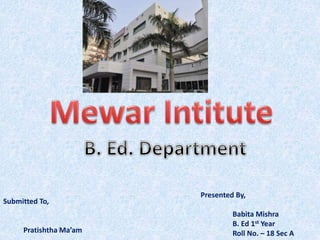Personality development by dr. Babita
- 1. Presented By, Babita Mishra B. Ed 1st Year Roll No. ŌĆō 18 Sec A Submitted To, Pratishtha MaŌĆÖam
- 3. ’āś The word personality comes from the Latin root persona, meaning "mask." According to this root, personality is the impression we make on others; the mask we present to the world. ’āś Personality is defined as "a unique set of traits and characteristics, relatively stable over time.ŌĆ£ The definition further suggests that personality does not change from day to day. Over the short-term, our personalities are relatively set or stable. However, definition does not suggest that personality is somehow rigid, unchangeable, and cast in concrete. Definition recognizes that, over a longer term, personality may change. Concept
- 4. Definitions ’āśJ.B. Watson (1930) : ŌĆ£ Personality is the sum of activities that can be discovered by actual observations over a long enough period of time to give reliable information.ŌĆØ ’āśM. Prince (1929): Personality is the sum total of all biological innate dispositions, impulses, tendencies, appetites, and instincts of the individual and the dispositions and tendencies acquired by experience.
- 5. ’āśAfter analyzing 49 definitions by eminent persons, Allport (1948) defined ŌĆ£Personality is the dynamic organization within the individual of those psychophysical systems that determine his unique adjustmentto his environment.ŌĆØ
- 6. Characteristics ’āśPersonality is an internal process that guides behavior. ’āśGordon Allport (1961) makes the point that personality is psychophysical, which means both physical and psychological. ’āśBiological and genetic phenomena do have an impact on personality. ’āśChild (1968) makes the point that personality is stable ŌĆō or at least relatively stable. ’āśChild (1968) includes consistency (within an individual) and difference (between individuals) in his definition, ’āśAllport (1961) refers to characteristic patterns of behavior within an individual.
- 7. Nature of Personality ’āś It is relatively stable but dynamic in nature. ’āś Helps in adjusting the individual with the environment. ’āś It is consistent. ’āś It is unique








